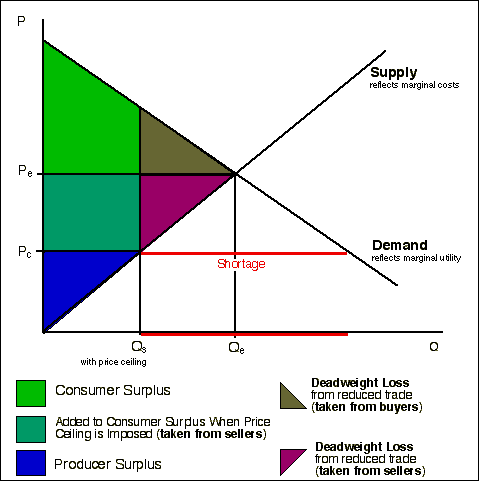
Price Floors
When a price floor is imposed (by a law stipulating a minimum price for a good or resource), sellers gain a larger producer surplus from the higher price, but buyers suffer. Also, since total trade is reduced, both buyers and sellers lose some welfare (consumer surplus and producer surplus) due to the loss of trade. These losses are referred to as "deadweight loss." Even though the sellers lose some of this deadweight loss, they may make up for it through the higher price. Buyers have no such compensation. In the diagram below, the price floor is indicated as PF.

Price Ceilings
When a price ceiling is imposed (by a law stipulating a maximum price for a good or resource), buyers gain a larger consumer surplus from the lower price, but sellers suffer. Also, since total trade is reduced, both buyers and sellers lose some welfare (consumer surplus and producer surplus) due to the loss of trade. As with a price floor, these losses are referred to as "deadweight loss." Even though the buyers lose some of this deadweight loss, they may make up for it through the lower price. Sellers have no such compensation. In the diagram below, the price ceiling is indicated as PC.

Taxes
When a tax is imposed, the effects on overall efficiency are similar to a price floor combined with a price ceiling. In the diagram below, the tax is indicated by the red bars, showing the wedge or gap in price between the higher price paid (ultimately) by buyers of the good and the lower price received by the sellers of the good. The price paid by buyers rises to PB (the higher price resembling the effect of a price floor). The price paid to sellers falls to PS (resembling the lower price of a price ceiling).
However, instead of the sellers or buyers getting an increase in producer surplus or consumer surplus, the government collects a bit of the former surpluses of both consumers and producers. This collection is called "revenue" for the government. The tax will reduce total trade, just like a price floor or price ceiling, but the reduced consumer surplus and producer surplus is often called the "excess burden," which is analogous to the "deadweight loss" with a price floor or a price ceiling (you can think of "excess burden" and "deadweight loss" as two names for the same idea).

Here's another view, with the individual areas labelled.
Move your mouse over an area to see its significance.









